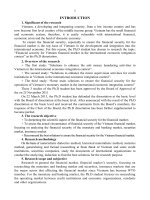Financial accounting in an economic context 8e chapter 04
Bạn đang xem bản rút gọn của tài liệu. Xem và tải ngay bản đầy đủ của tài liệu tại đây (689.01 KB, 50 trang )
Chapter 4:
The Mechanics of Financial
Accounting
2
Chapter 4: The Mechanics of
Financial Accounting
The first step in the accounting process is
transaction analysis.
This process examines relevant, objectively
measurable economic events through their
effect on the accounting equation:
Assets = Liabilities + Equity
3
Now look at E4-2 Spreadsheet
Using a spreadsheet approach, analyze the
transactions. (Spreadsheet on next slide.)
Note that effects may be on both sides of
the equation, in the same direction, or
effects may be on one side of the equation
with offsetting directions.
4
Exercise 4-2 Spreadsheet
1.
2.
3.
4.
5.
6.
Cash + A/R + Land = N/P + CC + RE
30,000
30,000
=
(20,000)
20,000 =
9,000
= 9,000
8,000 Rev.
8,000
=
(5,500)
(5,500) Exp.
=
(500) _____
(500) Div.
_____
_____= _____
_____
_____
Tot. 13,000 + 8,000 + 20,000 = 9,000 + 30,000 + 2,000
5
Exercise 4-2 Financial Statements
Income Statement
Revenues
$8,000
Expenses
5,500
Net Income
$2,500
Statement of Retained Earnings
RE (beginning)
$ 0
Add: Net Income 2,500
Less: Dividends (500)
RE (ending)
$2,000
6
Exercise 4-2 Financial Statements
Balance Sheet
Assets
Cash
$13,000
A/R
8,000
Land
20,000
Total
$41,000
Liabilities and S.E.
N/P
$ 9,000
CS
30,000
RE (ending)
2,000
Total
$41,000
7
Now look at E4-2 Spreadsheet
Note that the transaction analysis was
relatively simple with a few transactions
and a few accounts. However, with
thousands of transactions and hundreds
of accounts, the spreadsheet program is
inefficient.
Therefore accountants use a “double
entry” system based on debits and
credits.
8
Double Entry Accounting
Debit (dr) - means an entry to the left hand
side of an account.
Credit (cr) - means an entry to the right
hand side of an account.
Note that a debit or credit, per se, does not
indicate increase or decrease.
To decide the effect of a debit or credit,
the type of account must be considered.
9
Effect of Debits and Credits
Based on the accounting equation, we can increase or
decrease various accounts depending on their
classification:
Note that we use debits and credits instead of plusses and
minuses.
10
The following rules can be derived from
the basic formula:
Assets have normal debit balances and are
increased with a debit.
Liabilities and equities have normal credit
balances and are increased with a credit.
Revenues (a part of equity) have normal credit
balances and are increased with a credit.
Expenses (which decrease equity) have normal
debit balances and are increased with a debit.
Dividends (which decrease equity) have a
normal debit balance and are increased with a
debit.
11
The Format of a Journal Entry
To initially record transactions, we use a
journal entry to represent the debits and
credits.
For example, in E4-2, Item 1:
Debit Credit
Cash
30,000
Common Stock
30,000
Note that the debit is to the left and the credit
is to the right. First we list the account (left
hand entry on top), then the amount.
12
Now back to E4-2, and prepare the
other journal entries:
2: Purchased land for $20,000 cash.
Land
20,000
Cash
20,000
3: Borrowed $9,000 cash from bank.
Cash
9,000
Notes Payable
9,000
13
Now back to E4-2, and prepare the
other journal entries:
4: Provided services (on account) $8,000.
Accts. Receivable
8,000
Service Revenue
8,000
5: Paid $5,500 cash for expenses.
Expenses
5,500
Cash
5,500
14
Now back to E4-2, and prepare the
other journal entries:
6: Paid $500 cash dividend to owners.
Dividends
500
Cash
500
Note that dividends is a contra equity
account and ultimately reduces retained
earnings.
15
The Accounting Cycle
(more detail in Appendix 4A)
Components of the accounting cycle include:
A. Preparation of Daily Journal Entries
-Post to the General Ledger
-Unadjusted Trial Balance
B. Preparation of Adjusting Journal Entries
-Post to the General Ledger
-Adjusted Trial Balance
C. Financial Statements
D. Closing Journal Entries
-Final Trial Balance
16
A. Daily Journal Entries (DJEs)
The first step in the accounting process.
Prepared for daily activity.
Usually journalized in special journals for
efficiency, but we will record in “General
Journal” format.
Identified through a document flow:
– cash receipt, record a cash sale
– charge receipt, record a credit sale
– bank note, record a notes payable
– employee time card, record wages
E 4-2 transactions are DJEs.
17
Another Example of DJE
Often, investments and noncurrent assets are
sold for more or less than the amounts at which
they are carried on the balance sheet. In such
cases a gain (if a credit) or loss (if a debit) must
be recognized.
Ex: Land that cost $10,000 is sold for $11,000
cash. Prepare the GJE:
Cash
11,000
Land
10,000
Gain on Sale of Land
1,000
Note: gains are a form of revenues and losses
are a form of expenses on the income statement.
The sale of inventory is recorded in a different
manner – discussed in Chapters 4 and 7.
18
The General Ledger (G/L)
The G/L serves as a place to “total”
amounts by account titles.
After DJEs and AJEs are recorded, they
are posted (by account) to the G/L.
We will use “T” accounts to represent
G/L accounts where needed.
Appendix 4A discusses T accounts in
more detail.
19
Back to E4-2: Posting to G/L
Now post transactions (for cash) to “T” account:
Cash
30,000
9,000
20,000
5,500
500
Bal. 13,000
20
Unadjusted Trial Balance
Trial balances are prepared throughout the
accounting cycle.
The Unadjusted Trial Balance represents G/L
totals (by account) at a particular point in
time.
For E4-2, the Unadjusted Trial Balance would
consist of a list of all of the ending debit or
credit balances taken from the various “T”
account totals (illustrated on the next slide).
The Unadjusted Trial Balance is a preliminary
total, and is a starting point for the Adjusting
Journal Entries (discussed later in this
chapter).
21
Unadjusted Trial Balance - Exercise 4-2
(after posting and totaling G/L accounts)
Cash
Accounts Receivable
Land
Notes Payable
9,000
Contributed Capital
Retained Earnings
Totals
Debit
13,000
8,000
20,000
Credit
30,000
2,000
41,000
41,000
22
B. Adjusting Journal Entries (AJEs)
Prepared at the end of the accounting
period to align revenues and expenses
(matching).
Usually NO document flow to trigger
recording.
Based on the accrual system of accounting
which records revenues as earned and
expenses as incurred (rather than based
on cash flows).
23
Types of AJEs
1. Accrual of expenses
2. Accrual of revenues
3. Deferrals of expenses
4. Deferrals of revenues
5. Revaluation adjustments
24
Accrual System vs. Accrual AJEs
The “accrual system of accounting” and
“accrual of revenues and expenses” are
both discussed in this chapter.
Note that the “accrual of revenues and
expenses” is a subset of the AJEs
discussed in this chapter.
In comparison, the “accrual system of
accounting” refers to the entire process of
revenue and expense recognition, and
relates to the definitions of matching and
revenue recognition discussed in Chapter 3.
25









